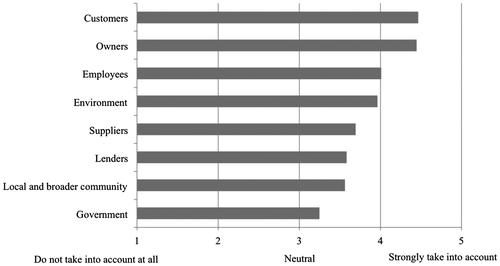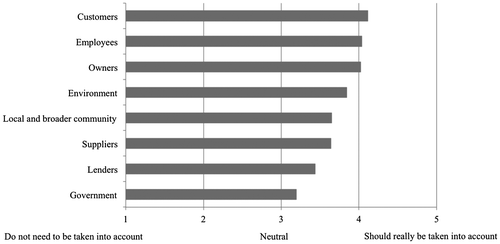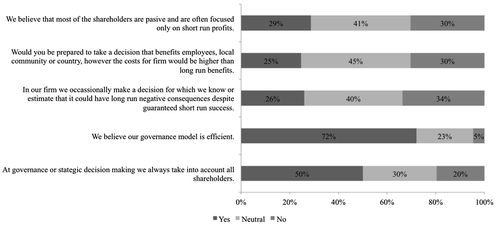Abstract
Firms are driving forces of economic and social development; therefore it is important to understand what is their primary goal or purpose. The aim of the paper is twofold. First, the paper presents baseline theoretical concepts on the firms’ purposes. Secondly, the paper presents the results of the empirical study in Slovenia with which we tried to determine how firms’ purposes are perceived by their managers and how they see their responsibility to owners and other stakeholders. The empirical study was based on a survey that was sent to the management of 1400 Slovenian medium-sized and big companies, of which about one third responded. The survey questionnaire was pre-tested through interviewing five top managers in five Slovenian firms with different ownership structure. On the basis of the empirical study it is possible to conclude that, on average, Slovenian firms put the interests of all stakeholders before the interests of only shareholders. So it seems that the majority of managers follow the stakeholder approach in the governance model.
1. Introduction
What is the purpose of a firm? In whose interests is it governed? To whom is the purpose of a firm subordinated? All of these questions, despite voluminous literature (Coffee, Citation1998; Collins & Porras, Citation1994; Gamble & Kelly, Citation2001; Jensen, Citation2001; Rose & Mejer, Citation2003; Senge, Citation2000) still remain at least partly unanswered. Although there are several studies that try to solve these questions for modern economies, there is a lack of empirical findings for post-transitional economies, despite the fact that firms’ functioning, operations and performance are important for their social and economic development. These modern economies have undergone a transition from state property or worker self-management (e.g. Slovenia) to private ownership, which might have distorted traditional concepts of corporate governance and, by this, the definition of a firm’s purpose.
This article has two main objectives. First, it provides an overview of some theoretical concepts on the issue of a firm’s purpose. We will follow two competing theories about the purpose of the modern firm; the shareholder and the stakeholder theories. We, however, acknowledge that in the management literature, a third approach also exists, one that emphasises delivering value to customers as the main purpose of the firm (Drucker, Citation1986, Citation1993a, Citation1993b, Citation1995, Citation1999). Second, the article presents the results of an empirical study on firms’ purpose for Slovenia, a post-transition economy, which has over the last two decades gone through the process of establishing a full market economy. The main aim of the empirical study is to identify the firms’ purposes from the perception of Slovenia managers and establish if corporate purpose orientation depends on size, type and/or ownership structure. In a similar vein, Yoshimori (Citation1995) examined the views of managers in Japan, Germany, France, the United States and the United Kingdom. He found that managers in Japan, Germany and France believe that the firm exists for the interests of all its stakeholders. On the other hand, most of the American and English managers argue that a firm should give first priority to shareholders’ interests. However, only few similar researches have been done in post-transitional countries where the transition from one to another type of ownership influenced the perception of the companies within the society (Biloslavo & Lynn, Citation2007).
The empirical part of the paper is based on a survey study. The survey questionnaire was pre-tested through interviewing five top managers in five Slovenian firms with different ownership structures (private, state, foreign and two mixed). The survey was then sent to the management of all Slovenian medium-sized and big companies (approximately 1400 in total), of which about one third responded. As regards the results of the survey study, the perception of the firm’s purpose significantly differs among Slovenian firms according to the type of ownership. On the other hand, no significant differences were recorded among Slovenian firms according to their size and type. Nevertheless, on average, Slovenian managers put the interests of all stakeholders before the interests of only the shareholders.
This article continues with an overview of the theoretical framework and empirical studies, by which we focus on two baseline theories, i.e. shareholder and stakeholder theory, and with a discussion on management values in post-transition countries. After an extensive overview of literature, we continue with the methodology and presentation of empirical findings. In the final section we offer our conclusions.
2. Literature overview
In the literature we can find two basic lines of thought regarding firms’ purpose. The first perceives firms as economic entities, aimed at increasing shareholder value. The second perceives firms as social institutions, aimed at promoting the interests of all firms’ stakeholders (i.e. shareholders, employees, creditors, suppliers, customers, local and broader community).
The shareholder approach, which states that managers are required to manage a firm in the interests of its shareholders, has always been the ruling concept in the Anglo-American corporate governance. According to Easterbrook and Fischel (Citation1996), the shareholders take the majority of the firm’s risk. Consequently, a firm has to be managed in accordance with their interests. Therefore, the shareholder value maximisation has to pursue two purposes: responsibility and efficiency. This ensures that managers are fully accountable to shareholders for their stewardship of the firm’s assets, making managers focused on a single clear objective, which ensures the most efficient outcomes (Gamble & Kelly, Citation2001).
With regard to the above interpretation, we may conclude that the shareholder theory raises no contradictions. However, this is not true in theory and even less in practice, mostly because of different cultural values that impact the institutional context and systems of corporate governance (Gamble & Kelly, Citation2001).
Goodpaster (Citation1991) pointed on the obvious paradox of the stakeholder approach: management has a contractual obligation to run the firm in the interest of shareholders and, at the same time, also a moral obligation to take into account the interests of all stakeholders (on this issue see also Boatright, Citation1994; Goodpaster & Holloran, Citation1994; Marens & Wicks, Citation1999).
2.1. Support for the shareholder theory
Several authors (Bradley, Schipani, Sundaram, & Walsh, Citation1999; Coffee, Citation1998; Hansmann & Kraakman, Citation2000; Höpner, Citation2001; Rubach & Sebora, Citation1998; Useem, Citation1999) support a shareholder-oriented company purpose because they believe it can be a source of competitive advantage. In a more globalised world and increasingly competitive international capital markets they believe that firms with a shareholder-oriented purpose have access to cheaper capital sources, providing them with a competitive advantage over firms with a more stakeholder-oriented purpose (Radosavljević, Anđelković, & Radosavljević, Citation2010). In a similar vein, Hansmann and Kraakman (Citation2000) showed that firms with a shareholder-oriented purpose enjoy competitive advantages because they are more flexible and adaptive to market changes. As these firms are not burdened with the interests of other stakeholders, they can adapt their management structures, enter the market more aggressively, and exit from inefficient investments more rapidly (Fiss & Zajac, Citation2004).
One of the strongest points of shareholder theory is that it offers a clear managerial objective that needs to be followed. Since a firm cannot maximise more than one strategic dimension at the same time, a single objective function is of utmost importance. Stakeholder theory, on the contrary, does not offer managers a clear managerial objective, as it does not explain how managers could choose between competing interests of stakeholders. If a manager has to simultaneously maximise profits, market share, firm growth, salaries and other elements of stakeholders’ interests this will hinder his or her decisions and cause confusion. As a consequence, stakeholder theory increases agency costs and economic inefficiency and can be ideal for managers who will try to follow their own (short-term) interests. So firms that adopt stakeholder theory are limited in their competition for survival (Jensen, Citation2001).
According to Jensen (Citation2001), the stakeholder theory, does not provide an answer to how to make a trade-off between different interests of all stakeholders and is harmful both for firm and for social welfare. This was confirmed also by empirical findings. Based on a case of small non-profit firms, Wruck, Jensen, and Barry (Citation1991) showed the consequences of following more objectives at the same time. According to the authors, maximisation of several objectives at the same time almost destroyed the firm. Likewise, Cools and van Praag (Citation2000), based on the analysis of 80 Dutch firms between 1993 and 1997, found that pursuing several objectives at the same time hinders firm’s competition. Jensen (Citation2001) states that setting the value-creation score foremost in a firm could stimulate and not hinder its progress. Based on firms’ examples, he showed that many firms have gone bankrupt because they did not devote enough attention to the value creation/destruction score.
Sundaram and Inkpen (Citation2004) promoted shareholder value maximisation as a decision-making rule that brings benefits to all stakeholders. Their recommendation is as follows: ‘maximise the long-run value for shareholders and you will maximise the value of firms on the long run’. In this regard they presented an example of Merck, which was identified by Freeman, Wicks, and Parmar (Citation2004) as a practical example of a successful stakeholders’ approach governed company. They specified the following rule of Merck: ‘Our ability to meet our responsibilities depends on maintaining a financial position that invites investment in leading-edge research and that makes possible effective delivery of research results’ (Merck, Citation2004). In other words, firms such as Merck need to achieve the required return for shareholders to fund investments that will in turn be beneficial for all its stakeholders (Sundaram & Inkpen, Citation2004).
2.2. Support for the stakeholder theory
Senge (Citation2000) presented an interesting definition of a firm as a living organism and not as a money making machine. As follows from history, nature itself makes a selection among organisms that have to pass a natural test of creating value. He believed that firms and economic systems are like living organisms, yet their test of survival operates with a long time lag. Following this reasoning, Senge (Citation2000) claimed that firms could also follow objectives other than only an increase of shareholder value.
In similar way, Freeman and Evan (Citation1990) argued that the interests of other stakeholders can be highly associated with a firm’s performance as well, implying that they too can face losses. On the contrary, shareholders are more secured as they can (usually) sell their stocks on a liquid market. Thus, managers should not be more devoted or responsible to owners, especially not on the expense of other stakeholders (Freeman et al., Citation2004).
Wallace (Citation2003) studied the issue of the long-term value for shareholders in the context of broader objectives of stakeholders. He found that long-term value creation is a necessary condition for maintaining corporate investment in stakeholder relationships. Namely, firms with higher levels of shareholder value creation have a stronger reputation for treating stakeholders well. On the other hand, firms that create a small value for shareholders end up short-changing their shareholders and also all their constituencies. Wallace (Citation2003) therefore claimed that investing in stakeholders can add value – an additional dollar spent on a relationship with stakeholders pays off as long as the present value of the expected (long-run) return is at least one dollar.
Allen, Carletti, and Marquez (Citation2009) developed a model of stakeholder capitalism. According to Allen et al., most of the literature deals with the question of whether firms are governed in accordance with the interests of shareholders. Nevertheless, in several countries firms do not focus only on the interests of shareholders, but also on other stakeholders. Using a simple model, Allen, Carletti, and Marquez (Citation2009) showed that a firm and (almost) all stakeholders are better-off if a firm concentrates on the interests of all stakeholders. Namely, their findings showed that in cases when firms also take into account the interests of other stakeholders (if this is not required by the law), this increases the firm’s value in comparison to firms focusing on shareholders alone. Some firms even consider the interests of other stakeholders if this is not directly associated with the value of a firm. However, this can result in increased prices of a firm’s goods and services, making consumers worse off. One of the limitations of their study is that they treat shareholders, stakeholders and consumers as different groups, although in practice they overlap (Allen et al., Citation2009).
Hillman and Keim (Citation2001) analysed a sample of 500 American S&P firms and found that investing in stakeholder management may be complementary to shareholder value creation and may provide a basis for competitive advantage, as it enables a firm to develop capabilities and resources that differentiate a firm from its competitors. As regards a firm’s participation in social issues, it may be understood as a transactional investment that can be easily copied by competitors.Footnote1 Hillman and Keim (Citation2001) suggested that if the activity is directly tied to primary stakeholders, investments might not only bring benefits to stakeholders but also result in an increased shareholders’ value. Participating in social issues that go beyond the direct stakeholders’ interests, however, may have a negative impact on the firm’s ability to create shareholders’ value. In the decision-making process firms can rely on the reasoning of Moran and Ghoshal (Citation1996), who claimed that things that are beneficial for society are not necessary bad for the firm, and what is good for the firm is not necessary a cost to society.
Koslowski (Citation2000) showed that shareholder value can be used as a principle of management control, but not as the firm’s objective. According to the author, the idea that the shareholder value maximisation is the firm’s only objective is a mistaken legacy of a transfer from a financial to an industrial firm. Namely, concentration on the shareholder value works as means to increase the allocation efficiency of investments, which is a desired effect.
Among all stakeholders of a firm, an increase of firm’s value is an objective only for shareholders. For other groups, this objective is just a precondition that enables the success of the firm as a whole. Following this, Koslowski (Citation2000) suggested that the main purpose why a company has been established should be the production of goods and services, and not the production of profits or shareholder wealth. However, this may only be accomplished if adequate return on investments is realised. From this perspective, the creation of shareholder value is only a precondition for achieving the main purpose of a firm; however, it is not the most important. Accomplishment of this condition enables a firm’s existence. The means of securing the purpose of the firm are, however, not the primary purpose of a firm.
3. Post-transition, management values and ownership
The theoretical claim that ownership matters and that the ownership structure has a strong influence on the behaviour of management was most visibly confirmed in Central and Eastern Europe (CEE) during the transition and post-transition period to market-based democratic societies after 1989. Mass privatisation as one of the central tenets of the early period of transition continues to have an enormous influence on the behaviour of the managers and on the prospects of firms in the post-privatisation period. This is the reason why the unique historical process of mass privatisation in CEE continues to draw the attention of academics, policy-makers, business groups and other groups of people interested in its socio-economic development.
The basic theoretical assumption behind mass privatisation was the claim that the CEE economies needed to establish ‘clearly defined property rights’ to create proper incentives for firms to start behaving efficiently. Regardless of how initial allocation of property rights would be established, the efficient markets would ensure that the property entitlements would be allocated to the most efficient property holders.
The problem with this theoretical assumption was that it neglected other important legal, economic and regulatory institutions that provide proper incentives for active restructuring and long-term competitiveness of firms. The crucial misunderstanding of the first and second generation of reformers in CEE was that they frequently mixed the goals and means of transition. In the area of transition, too many reformers viewed privatisation as a goal in itself, rather than as a mean to achieve goals, i.e., more competitive, more innovative and long-term competitive firms. This is one of the reasons why large-scale privatisation was conducted in haste, often without the proper regulatory and supervisory framework.
It has turned out, however, that the way the privatisation was conducted did matter. The initial design and ownership structure was also more important than previously thought. The regulatory and institutional framework, providing necessary incentives and support to conduct the demanding process of restructuring and improving competitiveness, also mattered. In the context of CEE, neither a thoughtful approach to the privatisation nor a comprehensive regulatory and supervisory framework existed.
According to the comprehensive empirical study by Estrin, Hanousek, Kočenda, and Svejnar (Citation2009), almost two decades after the implementation of mass privatisation, it is still not possible to clearly recognise that the privatised firms behave substantially more efficiently. It has to be added that the methodological issues relating to the studies of mass privatisation effects are truly immense. Nevertheless, according to the study of Estrin et al. (Citation2009) on the effects of privatisation in transition economies, the finding was that:
Privatisation per se does not guarantee improved performance, at least in the short and medium run. Type of private ownership, corporate governance, access to know-how and markets, and the legal and institutional system matter for firm restructuring and performance. Foreign ownership tends to have a positive effect on performance. The positive effect of privatisation to domestic owners, to the extent it exists, takes a number of years to materialise. (Estrin et al., Citation2009)
To overcome this impasse, a broader alliance of shareholders, more balanced and diversified, as well as an alliance with other stakeholders must be created. This transformation could be called a transition from privileged and protected rent-seekers toward a genuine development oriented society with balanced and well-articulated interests of both the shareholders and stakeholders alike. Only then would the advanced and sophisticated debate on shareholders versus stakeholders make sense for the transition economies and societies.
4. Slovenia: the institutional context
Considerable cultural and economic differences exist within the post-transitional economies of the CEE. National institutions, the mode of economic transformation, the general business environment and outside influences often influence corporate practice – including the use of mission statements – more than do the leaders, policies and cultures of individual firms (Hetrick, Citation2002; Korent, Đunđek, & Čalopa, Citation2014; Mesner-Andolšek & Štebe, Citation2005). During the economic transition of the 1990s, changes in management structures in the CEE were often modest or absent (Bojnec, Citation1999). Efficient and competitive firms continued to replace less efficient firms through 2000 (Bojnec & Xavier, Citation2004) and business cycles appeared to be following a relatively stable business cycle with a frequency of three to four years (Jagrič, Citation2003). Since Slovenia signed the accession to the European Union (EU) in 2004, the period referred to as ‘the decade of transition’ can be deemed over. The post-transition period is creating new economic challenges with increased competitive and presumably isomorphic pressure for business strategies to mimic European and global competitors. Additionally, since the majority of successful Slovenian companies were diversified across unrelated industries during the period of economic transition, or experienced greater slack in their competitive environment, a clear mission seems to be of utmost importance, both in terms of product-market and corporate identity.
Of the seven CEE nations that joined the EU in 2004 – Bulgaria, the Czech Republic, Hungary, Poland, Romania, Slovakia and Slovenia – Slovenia was most closely positioned among CEE nations to EU competition and business practice.
In the context of the Slovene normative development, the first Companies Act was adopted in 1993. It was based on the German and Austrian tradition of companies’ legislation and has been amended comprehensively several times since its first adoption. In particular, the joint stock companies are strictly regulated according to the legal principle that the statutes of the companies cannot adopt any rule that is not envisaged by the legislation. The regulation of the small- and medium-size companies allows for a greater autonomy. The publicly traded joint stock companies, listed on the Ljubljana Stock Exchange, are subjected to additional requirements, including the provisions of the Corporate Governance Code.
Despite the comprehensive legislation and rapid regulatory development, it has not effectively prevented corporate mismanagement and corporate frauds in the years before the crisis. Subsequently, however, the judicial practice dealing with the civil and criminal liability of the responsible persons is also becoming stricter.
5. Methodology
In studying the perception of managers on their firm’s purpose, in Slovenia, we applied a survey study. Before applying a survey we pre-tested it by interviewing five top managers in five firms with different ownership structures (private, state, foreign and mixed). Based on findings of the pilot test, we revised the survey and eliminated possible uncertainties.
The survey was sent to the management of all Slovenian medium-sized and big firms (i.e., firms with 50 employees or more). The population comprised approximately 1400 such firms, of which 399 firms responded. Due to a change in number of employees, 34 firms were excluded from the sample (for these firms the number of employees fell below 50 after we collected information about the firm), so the final sample comprised 365 firms. The survey included ten questions, of which three were referring to general information on the firm, while the rest were on managers’ perceptions on the firm’s purpose, their views on stakeholders, etc.Footnote2
The answers were processed via descriptive statistics. Using correspondence analyses we tested correlations between the answers and firm’s size, type and ownership, respectively. In order to test for the statistical significance of correlations we employed the Pearson Chi Square parameter.
6. Empirical results
In this section we first provide an overview of the sample studied and also of the descriptive statistics for each of the survey questions. In the second part of the analysis, we explore whether managers’ perceptions of their firm’s purpose differ based on the firm’s ownership structure. We also examined whether the perception of the firm’s purpose differs with firm’s size and type, yet results were not statistically significant and therefore we do not discuss them in the continuation of this paper.
6.1. Overview of the sample
The sample included 365 firms, of which 25% were big and 75% medium-sized, which fairly corresponds to the population structure (see, for example, the survey study by Kosi, Nastav, & Dolenc, Citation2012). Only 1% of firms were mostly financial, while the rest of the sample comprised equally of manufacturing and service firms. From this perspective, the sample is almost representative. Namely, the population has slightly less than 60% of manufacturing firms, slightly less than 40% of service firms, and a small percentage of financial firms. As regards the ownership, most of the firms in the sample were mostly privately owned (60%), 17% of firms were mostly foreign-owned, 10% were mostly family-owned and 13% were mostly state-owned. The population has about 22% of foreign-owned firms; however, for domestic firms the details on the ownership structure are not available.
6.2. Descriptive analysis of the survey
With our first question we tried to establish the managers’ general perception about their firm’s purposes and corporate governance model. The respondents had to choose from the 5-level Likert scale. The results show that managers mostly take into account the interests of all stakeholders, not only owners, even though value maximisation in the long run and firm survival in the long-run are very important. As can be seen from Figure , managers strongly agree with both (rather similar) statements (b) and (e), implying that all stakeholders (not only owners) are taken into account in decision-making and value maximisation of a firm. On the other hand, they, on average, disagree with statements (d) and (f) (and are indecisive on statement (g)), which emphasise the importance of shareholders only.
Figure 1. Firm’s purposes and corporate governance model. Source: Authors’ research and calculations.
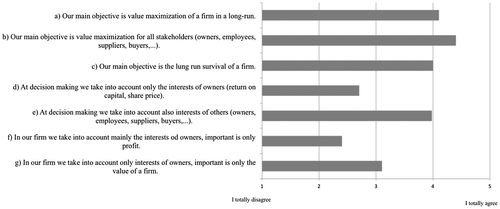
Figure presents the ranking of stakeholders by their importance for running a business. On average, the managers ranked highest customers and owners, followed by employees. Interestingly, the authorities deserved the least attention; in addition, lenders are not high in the ranking. The rankings provided by the managers are in line with their answers presented in Figure , especially statements (b) and (e) – they, on average, rank owners in similar manner as other stakeholders.
At the moment the study was undertaken, not all managers took into account all possible stakeholders, we further asked them which stakeholders (that are currently not properly considered) they would, if possible, also consider in the near future. As can be seen from Figure , the answers were rather similar to those of the previous question. Managers have a strong attitude to continuing to take into account the interests of customers, followed by employees and only then owners. The least consideration was given to government (the local and broader community moved higher up in the ranking) and lenders.
In parallel to that, we asked managers which stakeholders they could neglect easiest. The rankings are presented in Figure , by which those with a lower ranking could be neglected more easily than those with a higher ranking. As expected based on the previous two answers, the government’s interests could be neglected at first. Not consistent with the prior answers, though, is the rank of suppliers, which were high in the fifth rank. The interests of owners received the highest rank so their interests should be neglected last. Although the owners were the highest in the rank, the average value of their ranking is not significantly higher than the ranking value of customers and employees.
Figure 4. Ranking of stakeholders according to which interests could be neglected easiest. Source: Authors’ research and calculations.
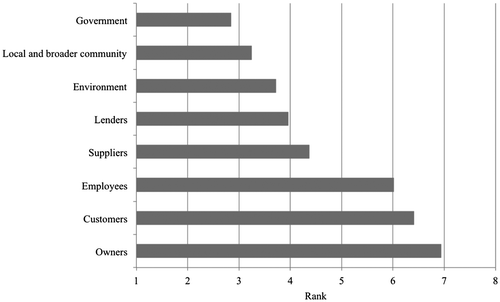
In one of the questions we asked managers why – in their own belief – they should take into account also the interests of other stakeholders (not only those of owners). Respondents could choose more answers (see Figure ). As expected, one answer received a significantly higher number of ticks. Managers take into account the interests of other stakeholders because they believe that this brings value added to their firm – almost 70% of managers chose (at least) this reason. This is in line with their strong agreement with statements (b) and (e) presented in Figure .
Figure 5. Reasons for taking other stakeholders’ interests into account. Source: Authors’ research and calculations.
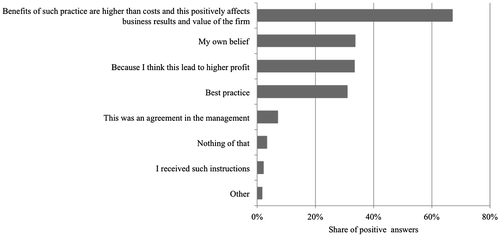
In the continuation of the study we selected several claims and asked managers if they agree with them or not (see Figure ). Managers most evidently agreed with the statement that their governance model is efficient (70% ticked ‘yes’). Surprisingly, a high percentage of managers could not decide on first the three claims, although those who decided on ‘yes’ or ‘no’, chose ‘no’ more often. Managers more or less do not take decisions which they (!) believe will have negative long-run consequences despite the positive short-run effect and they would not want to take business decisions with the awareness that they bring long-run negative effects even though they are beneficial to stakeholders other than for owners. And finally, as already noted in previous answers, managers also take into account the interests of other stakeholders when managing the firm and taking strategic decisions.
In the final question we asked managers what tend to be the important factors for the long-run success of a firm. The first two options were offered in the survey, and managers could also write and assess other options (these answers were then gathered in generic groups). It seems that these answers do not have a significant value added to our research as respondents listed all sorts of answers and factors of which all tend to be important or very important. However, we could see that, according to managers, the long-run success of a firm could be achieved when different stakeholders are satisfied with firm performance (see Figure ).
Figure 7. Important factors for long-run success of a firm. Source: Authors’ research and calculations.
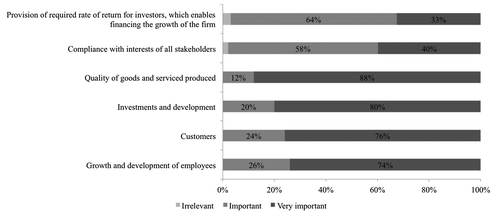
To summarise, managers’ responses to different survey questions are rather similar. Based on this overview we could conclude that the majority of Slovenian managers adopt a stakeholder approach as, besides the shareholders’ interests, they follow the interests of other stakeholders. This result is in line with similar research made by Figelj and Biloslavo (Citation2008) on a smaller sample of medium and large Slovenian processing companies.
6.3. Relationship between purposes of firms and ownership structure
In the final part of the analysis we tested the relationships between ownership structure and selected questions. The aim was to investigate whether management in firms with different ownership structures (i.e., different majority shareholders) have different views on corporate governance and firm purposes.
First, we took a look at the answers to the questions presented in Figure above. As can be seen from Figure , the perception of managers significantly differs by ownership structure in three statements (i.e., statements (a), (c) and (f)). As regards statement (f) (‘In our firm we mainly take into account the interests of owners, only profit is important’), it is obvious that the management in firms with foreign and family owners consider, on average, the interests of owners and through that pursue profit more than management in other firms. Nevertheless, for all of ownership types the average level of an answer is well below 3, so, in general, firms’ managements still mostly disagree with this statement. For statement (a) (‘Our main objective is value maximisation of a firm in the long-run’) it seems that value maximisation is the least important for management in state-owned firms and is (interestingly) most important for management in family-owned firms. From statement ‘c’ (‘Our main objective is the survival of a firm in the long-run’) we can conclude that survival of a firm is the main preoccupation of management in family- and state-owned firms.
Figure 8. Firm’s purposes and corporate governance model for different ownership structure. Source: Authors’ research and calculations.
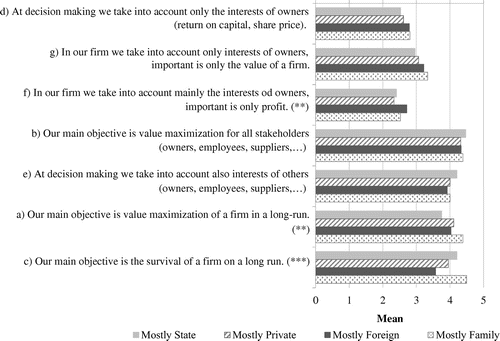
With regard to the ranking of stakeholders (see Figure ), there are significant differences in different ownership structures for almost all of the listed stakeholders. Owners, for example, are considered to be more important for management in foreign- and family-owned firms and less for management in state- and privately-owned ones. And, obviously and as expected, in state-owned firms the interests of the local and broader community, environment and government itself is evidently emphasised.
Figure 9. Ranking of stakeholders (current) for different ownership structure. Source: Authors’ research and calculations.
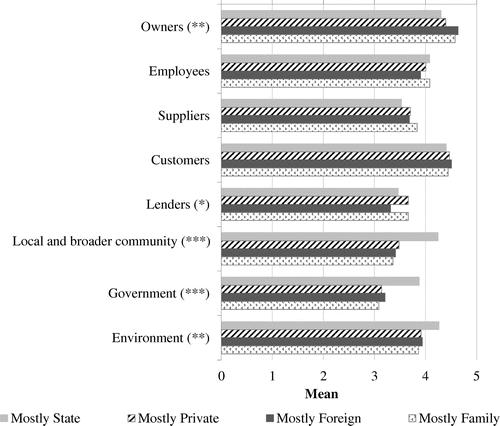
Some differences are also evident in the ranking of stakeholders whose interests could be neglected (see Figure ). Managers of foreign- and family-owned firms strongly emphasise that owners should not be neglected, and similarly for customers and employees. However, these managers believe that they could most easily neglect the interests of the local and broader communities and the interests of government. This is less true for managers of privately-owned firms and does not hold for managers of state-owned firms.
Figure 10. Ranking of stakeholders according to which interests could be neglected for different ownership structures. Source: Authors’ research and calculations.

We also tested differences in answers for other survey questions but have found no significant differences in relation to ownership structure.
7. Conclusion
This article attempts to provide an answer to a much-debated issue of firms’ purposes, with special attention being paid to a post-transition economy, Slovenia. In this regard, we followed two main objectives. First, we aimed to look the theoretical views on the question of a firm’s purpose, in relation to its governance model. We found two mainstream theories related to the purpose of a firm: (i) the shareholder theory, which supports the value maximisation for shareholders; and (ii) the stakeholder theory, according to which a firm should follow, as well as the shareholders’ interests, the interests of other stakeholders.
After examining the theoretical perspectives on firms’ purposes, we aimed to study the problem in Slovenia. In this regard we used a survey study, which helped us understand the thinking and acting of Slovenian managers. Owing to objective reasons we limited our research to medium-sized and large firms and carried out a vast survey analysis (after pre-testing it via interviews). The feedback was satisfactory enough to have a confidence in the results and conclusions of the research.
Two main messages of the empirical research could be underlined. First, on average, Slovenian firms put the interests of all stakeholders before the interests of only shareholders. This is evident from different questions and combinations of answers. It therefore seems that the majority of managers follow the stakeholder approach in the governance model. This is in a way also logical for at least two reasons. Slovenia is a part of the Continental-European business area, implying that it follows a similar governance approach. And second, due to the specific development of firms and their ownership structure after the transition to a market economy and privatisation, in many of the firms (claimed as privately-owned) the ownership structure changed from being concentrated to diffused (in many of the firms employees are part-owners), so the interests of ‘owners’ are not so emphasised. This can be backed with the findings of corresponding analysis. Indirect support to our findings can also be found in the research, conducted by Figelj and Biloslavo (Citation2008). They studied which, according to managers and experts, internal and external actors are the most influential in the Slovenian food industry. The study showed that managers perceive consumers to be the most influential actors, followed by owners, whereas experts believe that employees are the most influential.
As for the second main message, the perception of a firm’s purpose significantly differs among Slovenian firms according to the type of ownership. Even more, the answers of managers from foreign- and family-owned firms are, in several cases, similar; however, they are different from the answers of managers of state- and privately-owned firms. It therefore seems that firms where the owner is obvious (i.e., in foreign- and family-owned firms) could more easily identify themselves with the idea of shareholder theory than other firms. However, even in these firms, the ideas of stakeholder theory prevail. In this context, an additional dimension to the discussion between shareholder versus stakeholder theory could be added. Namely, the dividing line between the privileged and protected insiders versus excluded outsiders, as the outcome of mass privatisation during the period of transition, should be observed. This dividing line, which influences the behaviour of managers and firms in the post-transition period, would require additional theoretical and empirical research.
The article has important value added, as it tries to provide an answer to one of the basic questions of corporate governance theory, i.e., what is the purpose of a firm, both from a theoretical and an empirical point of view. Especially important are the empirical findings, as not many empirical studies have been done so far in this field, at least not for post-transitional economies and, to our knowledge, none for Slovenia. The empirical research raises interesting questions for research in other post-transition economies.
Disclosure statement
No potential conflict of interest was reported by the authors.
Notes
1. Organisations and their stakeholders are becoming aware of the need for and the benefits of socially responsible behaviour. An organisation's performance in relation to society and to its impact on the environment has become a critical part of measuring its overall performance and its ability to continue operating effectively (Peterlin, Dimovski, Uhan, & Penger, Citation2011).
2. The survey is available from the authors.
References
- Allen, F., Carletti, E., & Marquez, R. (2009). Stakeholder capitalism, corporate governance and firm value ( Wharton Financial Institution Center Working Paper, 09-28). Philadelphia: University of Pennsylvania.
- Biloslavo, R., & Lynn, M. L. (2007). Mission statements in Slovene enterprises: Institutional pressures and contextual adaptation in a post-transition economy. Management Decision, 45, 773–788.10.1108/00251740710746024
- Boatright, J. R. (1994). Fiduciary duties and the shareholder-management relation: Or, what’s so special about shareholders? Business Ethics Quarterly, 4, 393–407.10.2307/3857339
- Bojnec, Š. (1999). Privatisation, restructuring and management in Slovenian enterprises. Comparative Economic Studies, 41, 71–102.10.1057/ces.1999.19
- Bojnec, Š., & Xavier, A. (2004). Entry and exit in transition economies: The Slovenian manufacturing sector. Post-Communist Economies, 16, 191–214.10.1080/1463137042000223886
- Bradley, M., Schipani, C. A., Sundaram, A. K., & Walsh, J. P. (1999). Purposes and accountability of the corporation in contemporary society: Corporate governance at a crossroads. Law and Contemporary Problems, 62, 10–86.
- Coffee, J. C. Jr. (1998). Future as history: The prospects for global convergence in corporate governance and its implications. Northwestern University Law Review, 93, 641–707.
- Collins, J., & Porras, J. (1994). Built to last – Successful habits of visionary companies. New York, NY: HarperCollins Publishers Inc.
- Cools, K., & Praag, M. (2000). The value relevance of a single-valued corporate target: An empirical analysis. Social Science Research Network eLibrary, TI 2003 049/3.
- Drucker, P. F. (1986). Managing for results (2nd ed.). New York, NY: HarperBusiness.
- Drucker, P. F. (1993a). The concept of the corporation. New Brunswick. NJ: Transaction Publishers.
- Drucker, P. F. (1993b). The practice of management. New York, NY: HarperBusiness.
- Drucker, P. F. (1995). Managing in a time of great change. New York, NY: Penguin Putnam.
- Drucker, P. F. (1999). Management challenges for the 21st century. New York, NY: HarperBusiness.
- Easterbrook, F. H., & Fischel, D. H. (1996). The economic structure of corporate law. Boston, MA: Harvard University.
- Estrin, S., Hanousek, J., Kočenda, E., & Svejnar, J. (2009). Effects of privatization and ownership. Transition Economies Journal of Economic Literature, 47, 699–728.10.1257/jel.47.3.699
- Figelj, R. R., & Biloslavo, R. (2008). Vplivne skupine udeležencev v slovenski prehrambeni panogi [Influential groups of participants in the Slovenian food industry]. Organizacija, 41, 191–198.
- Fiss, P. C., & Zajac, E. J. (2004). The diffusion of ideas over contested terrain: The (non) adoption of a shareholder value orientation among German firms. Administrative Science Quarterly, 49, 501–534.
- Freeman, R. E., & Evan, W. E. (1990). Corporate governance: A stakeholder interpretation. Journal of Behavioral Economics, 19, 337–359.10.1016/0090-5720(90)90022-Y
- Freeman, R. E., Wicks, A. C., & Parmar, B. (2004). Stakeholder theory and the corporate objective revisited. Organization Science, 15, 364–369.10.1287/orsc.1040.0066
- Gamble, A., & Kelly, G. (2001). Shareholder value and the stakeholder debate in the UK. Corporate Governance: An International Review, 9, 110–117.10.1111/corg.2001.9.issue-2
- Goodpaster, K. E. (1991). Business ethics and stakeholder analysis. Business Ethics Quarterly, 1, 53–73.10.2307/3857592
- Goodpaster, K. E., & Holloran, T. E. (1994). In defense of a paradox. Business Ethics Quarterly, 4, 423–429.10.2307/3857341
- Hansmann, H., & Kraakman, R. (2000). End of history for corporate law ( Harvard Law School Discussion Paper, 280). Cambridge, MA: Harvard University.
- Hetrick, S. (2002). Transferring HR ideas and practices: Globalization and convergence in Poland. Human Resource Development International, 5, 333–351.10.1080/13678860210143569
- Hillman, A. J., & Keim, G. D. (2001). Shareholder value, stakeholder management, and social issues: What's the bottom line? Strategic Management Journal, 22, 125–139.10.1002/(ISSN)1097-0266
- Höpner, M. (2001). Corporate governance in transition: Ten empirical findings on shareholder value and industrial relations in Germany. Köln: Max-Planck-Institut Für Gesellschaftsforschung.
- Jagrič, T. (2003). Business cycles in Central and East European countries. Eastern European economies., 41, 6–23.
- Jensen, M. C. (2001). Value maximisation, stakeholder theory, and the corporate objective function. European Financial Management, 7, 297–317.10.1111/eufm.2001.7.issue-3
- Korent, D., Đunđek, I., & Čalopa, M. (2014). Corporate governance practices and firm performance measured by Croatian Corporate Governance Index (CCGI®). Ekonomska Istraživanja, 27, 221–231.10.1080/1331677X.2014.952109
- Kosi, T., Nastav, B., & Dolenc, P. (2012). Upravljanje raznolikosti v slovenskih in tujih podjetjih. Koper: University of Primorska.
- Koslowski, P. (2000). The limits of shareholder value. Journal of Business Ethics, 27, 137–148.10.1023/A:1006438000855
- Marens, R., & Wicks, A. (1999). Getting real: Stakeholder theory, managerial practice, and the general irrelevance of fiduciary duties owed to shareholders. Business Ethics Quarterly, 9, 273–293.10.2307/3857475
- Merck. (2004). Merck. Retrieved May 10, 2014, from http://www.merck.com/about/mission.html
- Mesner-Andolšek, D., & Štebe, J. (2005). Devolution or (de)centralization of HRM function in European organizations. International Journal of Human Resource Management, 16, 311–329.10.1080/0958519042000339525
- Moran, P., & Ghoshal, S. (1996). Theories of economic organization: The case for realism and balance. Academy of Management Review, 21, 58–72.
- Peterlin, J., Dimovski, V., Uhan, M., & Penger, S. (2011). Re-thinking the corporate social responsibility in Slovenia: Empirical evidence. Ekonomska istraživanja, 24, 125–141.
- Radosavljević, Ž., Anđelković, M., & Radosavljević, M. Ž. (2010). Competencies corporate governance in Serbia. Ekonomika, 3, 1–20.
- Rose, C., & Mejer, C. (2003). The Danish corporate governance system: From stakeholder orientation towards shareholder value. Corporate Governance: An International Review, 11, 335–344.10.1111/corg.2003.11.issue-4
- Rubach, M. J., & Sebora, T. C. (1998). Comparative corporate governance: Competitive implications of an emerging convergence. Journal of World Business, 33, 167–184.10.1016/S1090-9516(98)90004-9
- Senge, P. (2000). The puzzles and paradoxes of how living companies create wealth: Why single-valued objective functions are not quite enough. In M. Beer & N. Nohria (Eds.), Breaking the code of change (pp. 59–81). Boston, MA: Harvard Business School.
- Sundaram, A. K., & Inkpen, A. C. (2004). Stakeholder theory and the corporate objective revisited: A reply. Organization Science, 15, 370–371.10.1287/orsc.1040.0067
- Useem, M. (1999). Investor capitalism: How money managers are changing the face of corporate America. New York, NY: Basic Books.
- Wallace, J. S. (2003). Value maximization and stakeholder theory: Compatible or not? Journal of Applied Corporate Finance, 15, 120–127.10.1111/jacf.2003.15.issue-3
- Wruck, K. H., Jensen, M. C., & Barry, B. (1991). Fighton, Inc., (A) and (B) teaching note. Case #5. Boston: Harvard Business School.
- Yoshimori, M. (1995). Whose company is it? The concept of the corporation in Japan and the west. Long Range Planning, 28, 2–44.10.1016/0024-6301(95)00025-E

